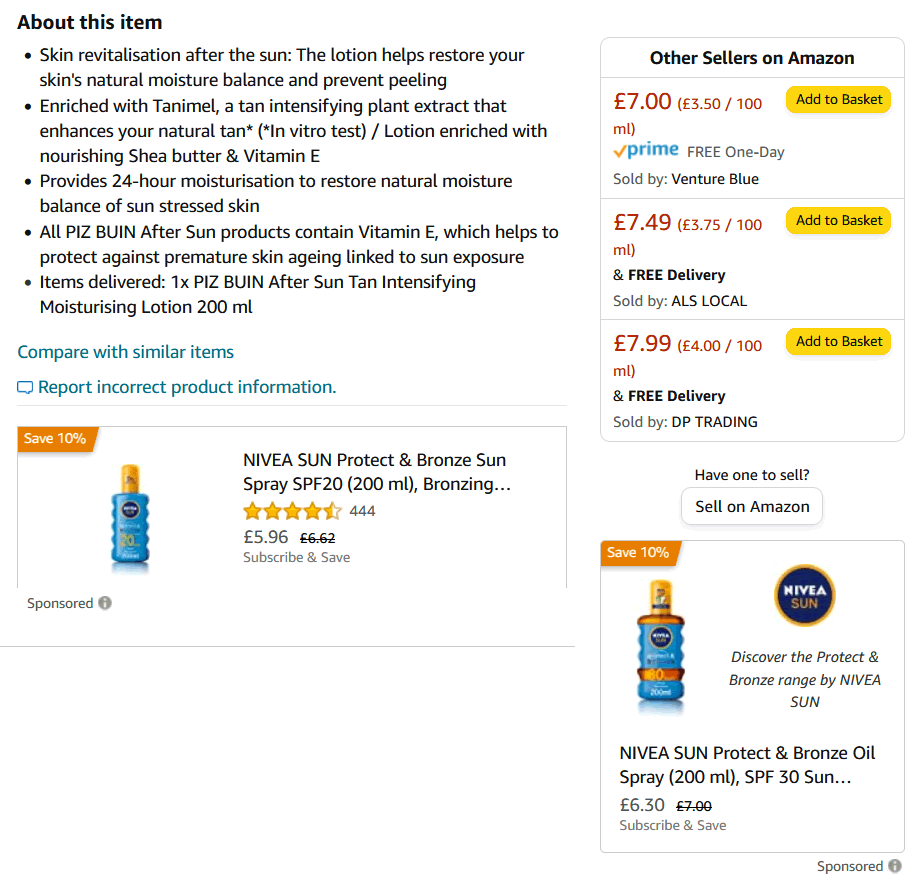This post is by Chris Turton, an ecommerce and Amazon consultant.
When Amazon’s Brand Registry first launched in 2015 it simply provided trademark owners with greater influence over the content of their product detail pages.
The benefits of Brand Registry have snowballed in the years since, to such an extent it seems like almost every new feature launched by Amazon is for registered brand owners only.
What are all the features available to brand owners on Amazon today? What are the limitations of Brand Registry, and how else can you protect your brand on Amazon?
What features does Amazon provide for brands?
Over the past five years, Amazon has invested heavily in supporting brands and manufacturers on its marketplace.
However, the process of getting your business onto Brand Registry, and gaining access to the toolset accompanying it, has become increasingly difficult. This is in part because Amazon has had to bolt on certain tools, and retrofit how it deals with existing products in its catalog. It has also had to address issues raised by major brands around counterfeiting and other intellectual property complaints.
The Brand Registry program allows brand owners to control product listings on Amazon, but it also provides a powerful array of brand management features. The tools currently available for brands are:
Brand Analytics
Brand Analytics is a toolset that allows sellers to report on Amazon’s most popular search terms, as well as look into repeat purchase behavior and market spend analysis.
Find out more about the Amazon Search Terms report and the Item Comparison and Alternative Purchase Behavior reports.
Manage Your Experiments
Manage Your Experiments allows you to perform A/B split tests across your product titles, images and A+ Content.
A/B testing allows you to determine which version of a particular product element works better for your buyers. For instance, you could test option A – a long detailed title against option B – a short punchy title. The results of the experiment would show you which version works better, so you can select the highest performer then make further comparisons to optimize your products.
Manage Your Experiments launched first in the US and has been available on Amazon UK and EU sites since July 2021.
Brand Stores
Amazon’s storefronts option has been available for a while now, allowing brands to create a mini site inside Amazon for all of its branded products.

A+ Content
This replaces the basic product description with a flexible visual design. On mobile, the A+ Content comes right under the product images making it a powerful option. On the desktop, it appears further down the page.
A+ Content can show key product elements as well as highlighting supported causes and other key brand values.
Product videos
Amazon product videos can make a significant difference to product conversion rates and are now available to all brand owners and their products.
Vine reviews
Since the Early Reviewer Program closed down in April 2021, Vine has become Amazon’s only remaining “legal” review system.
The scheme allows you to offer free products for review to “Vine Voices”. These are Amazon customers who have been recognized for the quality of their reviews. They rigorously test products and post detailed reviews, helping the customer to make an informed choice.
Sponsored Brands Ads
Sponsored Brands allows you to create a “banner” on Amazon showing up to three products from your brand for specific search terms.
This can help customers discover your brand while searching for a generic term such as “black woolen socks”. Sponsored Brands also allows you to create a video advert which will be displayed within the search page.

Sponsored Display Ads
Sponsored Display allows you to show one of your products in a prominent part of a competitor’s product detail page, typically under the bullet points. This targeted approach can be very effective.

Brand Catalog Manager (US Only)
The Brand Catalog Manager tool allows you to see all products from your Brand being sold on Amazon, regardless of who is selling them.
This can be exceptionally helpful and save hundreds of hours crawling product pages to find your brand’s products.
Customer Reviews (US Only)
The Customer Reviews page on the Brand Dashboard allows you to see and interact with customer reviews for your brand’s products, even if you are not the seller or Buy Box owner for the product.
This can be incredibly powerful data for your products and help provide feedback to your retailers.
Virtual bundles (US only)
The virtual product bundles tool for FBA lets brand owners create “bundles” of two to five related products which can be purchased together from a single product detail page. The products do not need to be packaged together so no additional physical work is required to offer the bundles – Amazon takes care of it in the fulfillment process.
Virtual bundles have been allowed on the vendor program for a number of years but now Amazon is allowing brand owners to create new products this way as well.
Amazon Live (US Only)
The marketplace giant’s recent foray into teleshopping allows brand owners to create powerful videos and live streams demonstrating their products on Amazon’s platform. All that is required is the Amazon Live creator app on your mobile device.
Is Amazon’s Brand Registry mandatory?
The Brand Registry program is not mandatory but it is very highly recommended for any brand that owns a trademark and whose products are sold on an Amazon marketplace. The tools provided are totally free to brand owners.
What are the limitations of Amazon’s Brand Registry program?
You must have a registered trademark issued by your local government intellectual property office in order to apply to the Brand Registry system.
A key misconception about the Brand Registry program is that it stops other sellers from offering your product, but this is not true. Being the brand owner does not make you the exclusive seller or improve your chances of winning Amazon’s coveted Buy Box.
How does my Brand Registry account connect to my seller account?
It is recommended when you sign up to the Brand Registry program that you use the same email address as the administrator login for your Amazon vendor or seller account.
Brand registration should automatically connect to your Seller Central or Vendor Central account once your brand has been approved, but this does not always happen. Check if your brand is connected by visiting Stores > Manage Stores. You may also need to visit the Amazon Advertising platform and click on Stores there to check if your brand is listed.
If it isn’t, contact Seller Support and explain the problem. They should be able to connect your account as long as your brand is registered successfully.
It is imperative that you have a trademark registered in the region where you are applying for Brand Registry. For example, if you only have an EU trademark then you will NOT be able to control your brand in the US.
Who has the ultimate control over a product listing?
The brand owner has the ultimate control, so you should be able to make adjustments to any part of your product detail page.
But if you have both a seller and vendor account, information submitted by the vendor always takes priority, so in that case use Vendor Central to make changes and modifications.
However, Amazon’s algorithm might not update the listing based on your submission, even if it is factually correct. If a change is rejected you will need to speak to Amazon support.
Can other sellers change the details for my brand’s products?
In theory, other sellers cannot make changes to your product detail pages. However, it does happen from time to time. Amazon’s official line is that they “take considerations from multiple contributors” on product listings.
If a product detail page changes without your authorization, first check that the product is correctly assigned to your brand and then contact Seller Support.
It should be even more difficult for anyone to make listing changes if your product falls under the Project Zero system mentioned below.
What happens if I own a brand license but I am not the brand owner?
Amazon has a hierarchy structure to its Brand Registry system. If you don’t own the brand but license it, you can ask the owner to go into Amazon’s Brand Registry system and give you administrator access. This will allow you to make changes on behalf of that brand.
The brand owner must have the trademark registered in the country where you are selling the product, and complete the Brand Registry application process.
How else can I protect my brand on Amazon?
Amazon’s Project Zero system helps brand owners who have had previous issues with counterfeiting to protect themselves from fake products.
If you have reported product violations to Amazon and had an acceptance rate of at least 90% in the last six months, you can enroll in Project Zero. This provides automated trademark protection tools, the ability to remove counterfeit products yourself, and an optional product serial number service.
This post was by Chris Turton, an ecommerce and Amazon consultant working with sellers in the US and the UK.
Chris provides services to businesses including ecommerce strategies, pricing and data analysis; eBay and Amazon listings and marketing; SEO, PPC and digital marketing; and Magento web design and development.

Leave a Reply